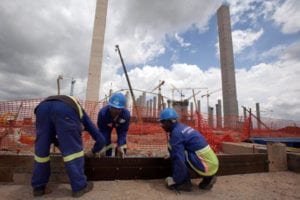Pictured: Projects are often delayed or sometimes even stopped during construction due to environmental or social issues that have been neglected prior to site establishment
The environmental management of construction, especially on complex, large-scale projects, has become a specialised activity that is multi-disciplinary in its approach. HatchGoba Environmental Services Group (ESG) regional director for Africa, Max Clark, says that the range of environmental, social and sustainability issues that need to be dealt with during the construction phase has grown tremendously over recent years. Clark points out that no longer is the focus on just preventing environmental impacts at the construction site, but also outside of the site with a great amount of emphasis being placed on cross-disciplinary matters. “HatchGoba’s ESG has developed an approach, which has been piloted internationally, to integrate environmental management with construction services in order to manage issues within and outside of the site more effectively,” explains Clark. He adds that as unlikely as it may have seemed years ago, currently the success of a project can now hinge on how environmental management is approached. HatchGoba’s ESG approach, manages the sustainability work stream, including environmental and social components, throughout the project lifecycle. HatchGoba ESG becomes an integral part of the construction team long before site establishment by getting involved from concept and prefeasibility stage – both of which set the scene for construction. The ever increasing scope of construction environmental management has resulted in the management of social issues and the fostering of sustainable development taking centre stage.“Through our experience on mega-projects of different kinds, we have identified several aspects that are important in construction environmental management, including: local procurement, selection of construction materials, job creation, workforce planning and training and community engagement. Furthermore, typical impacts that would require management on a construction site include: removal of vegetation, relocation of animals, relocation of rare species and plants noise management, air quality management and meeting permit conditions during construction,” explains Clark.
Projects are often delayed or sometimes even stopped during construction due to environmental or social issues that have been neglected prior to site establishment. Clark stresses that the cost impact resulting from these delays is usually considerable. HatchGoba’s ESG makes use of risk and opportunity assessments to develop an approachfor each aspect and impact, while consultation with the client and communities is used to refine it. The approach is multi-disciplinary with the environmental objectives being integrated into the roles of the construction team. HatchGoba’s ESG works closely with the overall project team to help manage each component of the Construction Environmental Management Plan (CEMP). Speaking on the social aspects that need to be considered in a construction project, Clark points out that the biggest shift has been seen in community engagement, which is no longer confined to the Environmental Impact Assessment (EIA). “Ongoing community participation during construction is important in order to identify and create opportunities for the community. In order to determine how much a community is benefiting from a new development, Hatch GobaESGconducts a comprehensive baseline of a community’s socio-economic status against which it measures impacts and programmes that are developed through community consultation. The sooner these programmes are established, the sooner benefits will start to be realised and project benefits to the community will be realised by all. It takes time to develop links with Non-Governmental Organisations (NGOs) working in the area and to establish a level of trust with the affected community. Interaction with local communities is of utmost importance – maintaining a good relationship with the local communities and the construction site workforce is critical. Imported workforces may be regarded as stealing jobs or not paying due respect to local customs. This education is integrated into awareness programmes, which are carried through to the induction process and implemented throughout the project lifecycle. Job creation is an important aspect of the CEMP in that a construction project can benefit affected communities by providing employment to unskilled and semi-skilled community members. Community members are provided with the opportunity to get work experience and develop new skills to improve their standard of living. This requires cooperation among social specialists from Hatch GobaESG, the recruitment team and the industrial relations practice. Clark concludes by saying that an integrated, multi-disciplinary approach during construction involving the environmental management team together with the other project disciplines is important in order to maximize environmental and socio-economic opportunities, to manage risk and to ensure successful project delivery.







